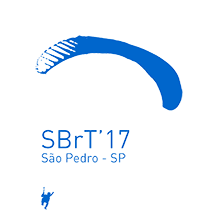
XXXV Simpósio Brasileiro de Telecomunicações e Processamento de Sinais
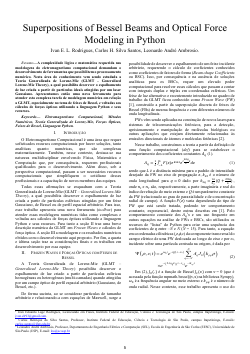
Superpositions of Bessel Beams and Optical Force Modeling in Python
Ivan E. L. Rodrigues, Carlos H. Silva Santos, Leonardo André Ambrosio
DOI: 10.14209/sbrt.2017.126
Keywords: Eletromagnetismo Computacional Métodos Numéricos Teoria Generalizada de Lorenz-Mie Forças Ópticas Feixes de Bessel Linguagem Python
Abstract
A complexidade lógica e matemática requerida nas modelagens do eletromagnetismo computacional demandam o desenvolvimento de ferramentas que possibilitem o processamento numérico. Nesta área do conhecimento vem sendo estudada a Teoria Generalizada de Lorenz-Mie (GLMT – Generalized Lorenz-Mie Theory), a qual possibilita descrever o espalhamento de luz criada a partir de partículas ideais atingidas por um laser Gaussiano. Apresentamos então uma nova ferramenta para atender esta complexa tarefa de modelagem numérica em relação a GLMT, especialmente no tema de feixes de Bessel, e voltadas aos cálculos de forças ópticas utilizando a linguagem Python e seus recursos.Download
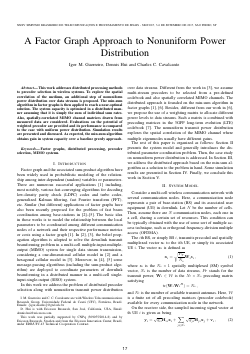
A Factor Graph Approach to Nonuniform Power Distribution
Igor M. Guerreiro, Dennis Hui, Charles C. Cavalcante
DOI: 10.14209/sbrt.2017.129
Keywords: Factor graphs distributed processing precoder selection MIMO systems
Abstract
This work addresses distributed processing methods to precoder selection in wireless systems. To explore the spatial correlation of the medium, an additional step of nonuniform power distribution over data streams is proposed. The min-sum algorithm in factor graphs is then applied to reach a near-optimal solution. The system capacity is optimized in a distributed man- ner assuming that it is simply the sum of individual sum rates. Also, spatially-correlated MIMO channel matrices drawn from measured data are considered. Evaluations on the potential of weighted precoder are provided and its performance is compared to the case with uniform power distribution. Simulation results are presented and discussed. As expected, the min-sum algorithm obtains gain in system capacity over a baseline greedy approach.Download

Atenuação dos efeitos da temperatura ambiente em redes OCDMA 2-D utilizando controle de potência baseado em algoritmo de enxame de vaga-lumes
Thiago dos Santos Cavali, Fábio Renan Durand, Taufik Abrão
DOI: 10.14209/sbrt.2017.127
Keywords: Optical Networks Firefly Algorithm Power Control
Abstract
This paper presents an approach for power control in OCDMA 2-D (Time/Wavelength) networks taking in account the adverse effects of environmental temperature variation in optical fibers. The proposed system uses a meta-heuristic based on behavior of firefly swarms to optimize the allocated power for each user in the network. The network structure and the optimization algorithm, as well the computational simulations are implemented in MATLAB® environment. The obtained results are analyzed based on variation in code parameters and show that the algorithm is efficient to realize the power control in OCDMA networks.Download
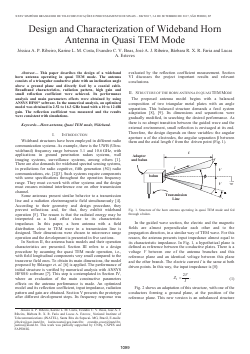
Design and Characterization of Wideband Horn Antenna in Quasi TEM Mode
Jéssica A. P. Ribeiro, Karine L. M. Costa, Evandro C. V. Boas, José A. J. Ribeiro, Bárbara R. X. R. Faria, Lucas A. Esteves
DOI: 10.14209/sbrt.2017.130
Keywords: Horn antenna Quasi TEM mode Wideband
Abstract
This paper describes the design of a wideband horn antenna operating in quasi TEM mode. The antenna consists of a triangular conductive plate with an inclination angle above a ground plane and directly feed by a coaxial cable. Broadband characteristics, radiation pattern, high gain and small reflection coefficient were achieved. Its performance analysis and main parameters effects were obtained by using ANSYS HFSS® software. In the numerical analysis, an optimized model was obtained in 2.52 to 16.3 GHz band with a 10 to 12 dBi gain. The reflection coefficient was measured and the results were consistent with simulations.Download
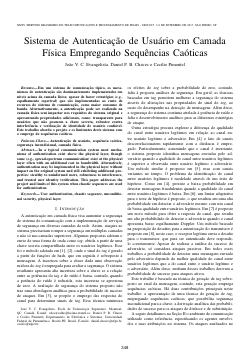
Sistema de Autenticação de Usuário em Camada Física Empregando Sequencias Caóticas
João V. C. Evangelista, Daniel P. B. Chaves, Cecilio Pimentel
DOI: 10.14209/sbrt.2017.131
Keywords: User authentication chaotic sequence unconditional security physical layer
Abstract
In a typical communication system most mechanisms of authentication exist above the physical layer, though some (e.g., spread-spectrum communication) exist at the physical layer often with an additional cost in bandwidth. Alternatively, authentication may be implemented in the physical layer without impact on the original system and still exhibiting additional properties: stealthy to uninformed users, robustness to interference, and trusted user identity verification. This paper addresses the project and limits of this system when chaotic sequences are used for authentication.Download
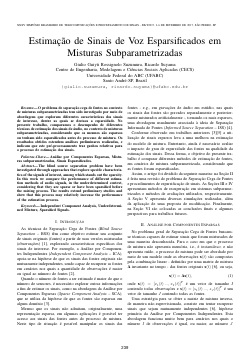
Estimação de Sinais de Voz Esparsificados em Misturas Subparametrizadas
Giulio Guiyti Rossignolo Suzumura, Ricardo Suyama
DOI: 10.14209/sbrt.2017.128
Keywords: Análise por Componentes Esparsas Misturas subparametrizadas Sinais Esparsificados
Abstract
O problema de separação cega de fontes no contexto de misturas subparametrizadas tem sido investigado por meio de abordagens que exploram diferentes características dos sinais de interesse, dentre as quais se destaca a esparsidade. No presente trabalho, comparamos o desempenho de diferentes técnicas de estimação dos sinais de áudio, no contexto de misturas subparametrizadas, considerando que os mesmos são esparsos ou tenham sido esparsificados antes do processo de mistura. Os resultados obtidos estendem análises preliminares realizadas, e indicam que este pré-processamento traz ganhos relativos para o processo de estimação dos sinais.Download

Detecção de pessoas em um ambiente industrial utilizando imagens de profundidade e classificadores profundos
Eduardo Henrique Arnold, Danilo Silva
DOI: 10.14209/sbrt.2017.132
Keywords: Human detection depth images deep learning convolutional networks machine learning computer vision
Abstract
This paper describes the development of an indus- trial safety system that requires automatic human detection. Two solutions based on top-view depth images are presented. The first one is based on traditional learning techniques using feature extraction and a Support Vector Machine classifier. The second solution uses deep learning methods for classification. The performance analysis of both solutions revealed that the deep learning methods outperform traditional learning techniques on this task, at the cost of requiring a larger training set and increased computational cost.Download
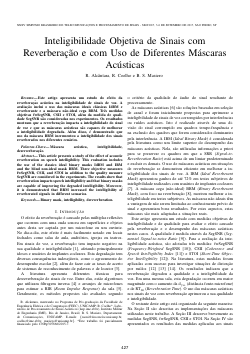
Inteligibilidade Objetiva de Sinais com Reverberação e com Uso de Diferentes Máscaras Acústicas
R. Alcântara, R. Coelho, B. S. Masiero
DOI: 10.14209/sbrt.2017.106
Keywords: Binary mask intelligibility dereverberation
Abstract
This article presents a study of the effect of acoustic reverberation on speech intelligibility. This evaluation includes the use of the classics ideal binary masks IdBM and IRM and the blind non-ideal mask BRM. Three objective measures fwSegSNR, CSII, and STOI in addition to the quality measure SegSNR are considered in the experiments. The results show that reverberation impacts speech intelligibility and that binary masks are capable of improving the degraded intelligibility. Moreover, it is demonstrated that BRM increased the intelligibility of reverberated signals in different scenarios.Download
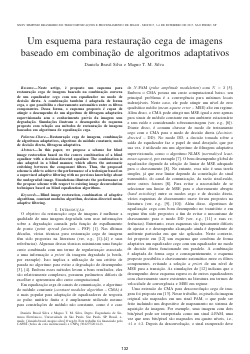
Um esquema para restauração cega de imagens baseado em combinação de algoritmos adaptativos
Daniela Brasil Silva, Magno T. M. Silva
DOI: 10.14209/sbrt.2017.262
Keywords: Blind image restoration combination of adaptive algorithms constant modulus algorithm decision-directed mode adaptive filtering
Abstract
In this paper, we propose a scheme for blind image restoration based on the convex combination of a blind equalizer with a decision-directed equalizer. The combination is also adapted in a blind manner, which allows the automatic switching between the component filters. Thus, the proposed scheme is able to achieve the performance of a technique based on a supervised adaptive filtering with no previous knowledge about the undegraded image. Simulations illustrate the performance of the propose scheme with respect to existing image deconvolution techniques based on blind equalization algorithms.Download

Current Consumption in Radio Modules for Wireless Sensor Networks
Felipe Antonio Moura Miranda, Paulo Cardieri
DOI: 10.14209/sbrt.2017.107
Keywords: Current Consumption Radio Modules Measurement Wireless Sensor Networks
Abstract
This paper presents results of an experimental work designed to investigate current consumption in radio modules commonly used in Wireless Sensor Networks (WSNs). Using high speed measurement setup, we collected current consumption profiles (waveforms) of several radio modules in different states, including transmitting, receiving and idle states. Results showed a much more detailed current consumption when compared with the information provided in datasheets. Radio modules used in WSN usually operate under energy-limited conditions and detailed current consumption profiles, such as those presented in this paper, can be useful when designing energy-aware protocols or subsystems.Download